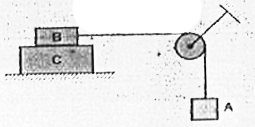The blocks A and B shown in figure have masses and . The system is released from rest. The speed of B after A has travelled a distance along the incline is

(a)
(b)
(c)
(d)
The correct Answer is:C
If A moves down the incline by , B shall move up by .
If the speed of B is v, then the speed of A will be .
From conservation of energy,
Gain in KE=loss in PE
Solving, we get
Topper's Solved these Questions
- WORK, POWER & ENERGYBOOK - CENGAGE PHYSICS ENGLISHCHAPTER - WORK, POWER & ENERGYEXERCISE - Multiple Correct
25 Videos
- WORK, POWER & ENERGYBOOK - CENGAGE PHYSICS ENGLISHCHAPTER - WORK, POWER & ENERGYEXERCISE - Linked Comprehension
55 Videos
- WORK, POWER & ENERGYBOOK - CENGAGE PHYSICS ENGLISHCHAPTER - WORK, POWER & ENERGYEXERCISE - Subjective
23 Videos
- VECTORSBOOK - CENGAGE PHYSICS ENGLISHCHAPTER - VECTORSEXERCISE - Exercise Multiple Correct
5 Videos
Similar Questions
Two blocks A and B are shown in figure have masses 5 kg and 4kg respectively. The system is released from rest. The speed of B after A has travelled the distance 1 m along the incline is (take g=10ms2 ,pulleys and strings are ideal and plane is smooth)
View SolutionIn the arrangement shown in figure mA=4.kg and mB=1.0kg. The system is released from rest and block B is found to have a speed 0.3m/s after it has descended through a distance of 1.m find the coefficient of friction between the block and the table. Neglect friction elsewhere. (Take g=10m/s2).
 .
.
View SolutionIn the arrangement shown in figure mA=4.kg and mB=1.0kg. The system is released from rest and block B is found to have a speed 0.3m/s after it has descended through a distance of 1.m find the coefficient of friction between the block and the table. Neglect friction elsewhere. (Take g=10m/s2).
 .
.
View SolutionBlocks A and B shown in the figure are having equal masses m. The system is released from rest with the spring unstretched. The string between A and ground is cut, when there is maximum extension in the spring. The acceleration of centre of mass of the two blocks at this instant is

View SolutionA block of mass M is placed on the top of a bigger block of mass 10 M as shown in figure. All the surfaces are frictionless. The system is released from rest, then the distance moved by the bigger block at the instant the smaller block reaches the ground :

View SolutionConsider the situatioin shown in figure. The system is released from rest and the block of mass 1.0 kg is found to have a speed 0.3 m/s ater it has descended thrugh a distance of 1 m. find the coefficient of kinetic friction between the block and the table.

View SolutionThe system shown in the figure is released from rest. At the instant when mass M has fallen through a distance h, the velocity of m will be

View SolutionIn the figure shown co-efficient of friction between the block B and C is 0.4. There is no friction between the block C and hte surface on which it is placed. The system of blocks is released from rest in the shown situation. Find the distance moved by the block C when block A descends through a distance 2m. Given masses of the blocks are mA=3kg,mB=5kgandmC=10kg.

View SolutionTwo block A and B are arrenged as shown in figure (mA=5kgandmB=10kg) Find the acceleration of blocks if F=40N

View SolutionA smooth block of mass m is held stationary on a smooth wedge of mass M and inclination θ as shown in figure .If the system is released from rest , then the normal reaction between the block and the wedge is

View Solution
